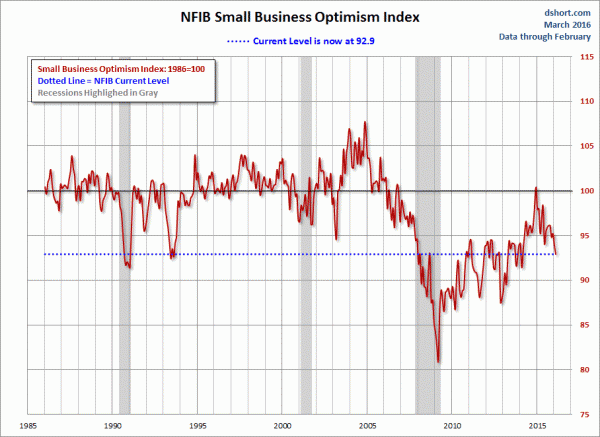The February NFIB Small Business Optimism report was released today, March 8, 2016. The headline of the Small Business Economic Trends report is “Small Business Optimism Hits Two-Year Low.”
The Index of Small Business Optimism dropped 1.0 points in February to 92.9.
Here are some excerpts from that I find particularly notable (but don’t necessarily agree with):
The percent of owners citing the difficulty of finding qualifed workers as their Single Most Important Business Problem fell 3 points to 12 percent, still number three on the list of problems behind taxes and regulations and red tape, and historically high.
also:
INVENTORIES AND SALES
The net percent of all owners (seasonally adjusted) reporting higher nominal sales in the past 3 months compared to the prior 3 months improved 1 point, rising to a net negative 6 percent on the back of a solid January consumer spending number. Eleven percent cited weak sales as their top business problem, down 1 point. Overall, this is not a strong sales picture. Expected real sales volumes posted a 3 point loss, falling to a seasonally adjusted net 0 percent of owners expecting gains. This is well below the average 14 point reading in the first three months of 2015. Owners aren’t expecting a very energetic opening to the year.
also:
CAPITAL SPENDING
Fifty-eight percent reported capital outlays, down 3 points. Overall, capital spending weakened again in February. The percent of owners planning capital outlays in the next 3 to 6 months fell 2 points to 23 percent. Clearly, expectations for the economy are not conducive to an improvement in business investment.
also:
CREDIT MARKETS
Four percent of owners reported that all their borrowing needs were not satisfied, 2 points above the record low reached in September 2015. Thirty-one percent reported all credit needs met (down 4 points), and 52 percent explicitly said they did not want a loan. For most of the recovery, record numbers of firms have been on the “credit sidelines”, seeing no good reason to borrow. Only 3 percent reported that financing was their top business problem compared to 21 percent citing taxes, 19 percent citing regulations and red tape and 12 percent citing the availability of qualified labor. When credit is an issue, owners report it as illustrated by 37 percent reporting credit hard to get in the early 1980s compared to 5 percent today. The Fed reported that business lending is on the rise, but there is little evidence of this among NFIB’s 350,000 member firms.
Here is a chart of the NFIB Small Business Optimism chart, as seen in the March 8 Doug Short post titled “NFIB: Small Business Survey 'Just Treading Water'“:
–
Further details regarding small business conditions can be seen in the full February 2016 NFIB Small Business Economic Trends (pdf) report.
_____
The Special Note summarizes my overall thoughts about our economic situation
SPX at 1993.84 as this post is written

No comments:
Post a Comment